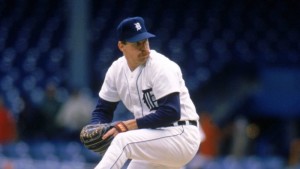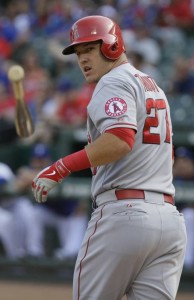Wake Up Baseball Fans – WAR is Fake and Meaningless
As a baseball fan who has been paying attention to baseball stats since the early 1970s when my primary motivation to learn to read was so I could read the statistics on the back of baseball cards, I have reached my limit with those baseball “stat geeks” who have taken the game I love and turned it into a mathematical equation that seems more designed to show how smart they are rather than really identifying who the best baseball players are.
I started reaching my limit over the last several years when the sabermetrics craze has minimized some baseball greats while pushing others to a higher level, regardless of what their real statistics say.
The greatest example of this is Los Angeles Angels star Mike Trout. If you judge baseball based simply on sabermetrics, you will likely try to argue that he is the greatest baseball player since Babe Ruth, heck, maybe even better.
Now, don’t get me wrong, Mike Trout is a great player, but I am not yet ready to consider him in the same conversation as some of the all-time greats.
Earlier this year, there was an article claiming that Trout was on his way to having the greatest single season in baseball since Ruth. That sounds amazing, but at the time he was hitting .below .300 and was not ranked among the league leaders in home runs or runs batted in.
What the sabermetrics folks have done is change the definition of what is considered important in judging the success and greatness of a baseball player.
For generations, batting average, home runs, extra base hits and runs batted in were the primary stats used to judge greatness. Heck, those were most of the stats listed on baseball cards when I was growing up. Secondary to those would be things like runs scored, on base percentage and slugging percentage.
Beginning in the mid-1980s with the publication of Bill James Baseball Abstract and continuing at a greater pace as fantasy baseball (originally known as rotisserie baseball) started building in popularity, there has been a growing desire among some baseball fans to look at the value of players in different ways.
Bill James originally devised the idea of “win shares” and that concept has been taken to a greater extent through sabermetrics with what is now considered by some baseball fans as “THE” measurement statistic of a player’s value known as WAR (Wins Above Replacement).
While I am not going to pretend to know enough about WAR to explain how it is computed, it is very clear that at some level WAR is designed to reward players who do more than just get base hits, drive in runs and hit home runs. Players who score well in WAR tend to get on base a lot, score runs and are quality defensive players.
In 2012 there was quite an uproar when the old school baseball definition of greatness clashed head-on with the new school definition of value for the American League Most Valuable Player Award.
At first glance, the 2012 AL MVP voting should have been a “no brainer”. Detroit Tigers slugger Miguel Cabrera had an amazing season in becoming the first American Leaguer since Carl Yastrzemski in 1967 to win the triple crown (lead the league in home runs, batting average and RBIs).

Jack Morris won 254 career games, but did not compile a high career total WAR (wins above replacement).
However, because we live in a new age of sabermetrics, there was a growing group who believed Trout, a rookie who began the season in the minors, was the real MVP.
Certainly Trout’s numbers were solid, especially for a rookie, as he hit .326 with 30 home runs and 83 RBI. He also scored 129 runs, had 49 stolen bases, .564 slugging percentage and an on base percentage of .399. However, given that Cabrera hit .330 with 44 home runs, 139 RBI, 109 runs, .606 slugging percentage and a .393 on base percentage, his numbers are certainly not comparable.
But, that gets us into this fake stat of WAR. According to sabermetrics, Trout had a total (counting offense and defense) WAR of 10.5 while Cabrera had a WAR of 7.1. Taking into account only their offensive WAR numbers, the fake stat still said Trout was more important to his team at 8.7, compared to 7.7 for Cabrera.
I am sorry, but I do not understand how someone with a lower batting average and slugging percentage as well as significantly fewer RBIs, while having only a marginally higher number of runs scored and on base percentage can be considered as being better.
Fortunately, the MVP voters sided with me as Cabrera won the award. He received 22 of the 28 first place votes with Trout getting the other six.
But, the obsession by “stat geeks” over Trout goes well beyond simply that he was more deserving of the MVP Award than Cabrera.
While WAR seems to give great value to getting on base, it seems to be less interested in rewarding clutch hitting or punishing strikeouts.
In 2014, Trout won his first MVP award while hitting .287 with 36 home runs, 111 RBI and 115 runs scored. He also led the league with 184 strikeouts while walking 83 times and having an on base percentage of .377. However, when hitting with two outs, Trout hit only .196 with one home run, 18 RBI and an OPS of .626. Yet, his offensive WAR was 8.8.
By comparison, Baltimore Orioles centerfielder Adam Jones hit .281 with 29 home runs, 96 RBI and 88 runs scored. Not known for patience at the plate, Jones had a .311 on base percentage with 19 walks and 133 strikeouts. However, with two outs, Jones was significantly more clutch than Trout with a .293 average, 11 home runs, 31 RBI and a .790 OPS. Yet, Jones had an offensive WAR of only 4.4.
Now, I am not arguing that Jones had an overall better season than Trout, but if the purpose of WAR is to identify who was more valuable, it seems to me that someone who hits .293 with 31 RBI with two outs is significantly more valuable than a player who didn’t even crack the Mendoza line with two outs.
Another issue related to WAR is exactly who is this “replacement” player and how can you really assess value of a player compared to what would happen if that player was not in the lineup?
Well, in 2017 the Los Angeles Angels had a pretty extensive sample size for what would happen if Mike Trout was not in the lineup as he missed 58 games due to injury. In the 114 games that Trout played, the Angels were 57-57. With him out of the lineup, the Angels went 23-25 to finish overall at 80-82.
Now, math isn’t my greatest strength, but that to me would equal a wins above replacement for Trout of 2. But, according to sabermetrics, Trout had an offensive WAR of 7.1 and a total WAR of 6.7.
I am sorry, but that just doesn’t make sense and seems to better than anything else illustrate that the WAR statistic is set in a manner that really has little to do with the overall value of a player.
Of course, sabermetrics has also become popular among some baseball executives as a way to evaluate talent. The best known example is Billy Beane with the Oakland A’s, whose book and subsequent movie Moneyball focused on how he used statistics to craft the lineup for the 2001 A’s. Similar use of statistics is also credited with being important to the success of Theo Epstein in ending World Series droughts in Boston and Chicago.
However, while statistics can perhaps play a valuable role in how a team crafts its roster, that doesn’t necessarily mean that making up statistics to try and judge the value of a player compared to others is justified and accurate.
I was especially struck by an article this week that lamented the selection this year of Jack Morris to the Baseball Hall of Fame because his career WAR of 44.0.
To me, Morris is a great example of how much of a joke WAR is. Despite winning 254 games, including 18 or more games six times, and pitching 235 or more innings in 11 seasons, Morris had a very minimal career WAR.
While Morris was perhaps not a “slam dunk” Hall of Famer, he had a .577 career winning percentage and won more games than any other pitcher in the 1980s. He also was the winning pitcher in one of baseball’s most famous pitcher’s duels in the seventh game of the 1991 World Series. One wrap against Morris was his career ERA of .3.90, but that is a bit misleading as he had an ERA above 4.00 in five of his last six seasons to dramatically inflate his career number.
The article referenced one of the sabermetric poster-boys in Bert Blyleven, who received very little Hall of Fame respect until “stat geeks” began touting his great secondary stats and career WAR. Though Blyleven won 18 or more games only twice in his 22 year career and had a career winning percentage of .534 (287-250), he somehow compiled a career war of more than double Morris at 96.6.
The result was that Blyleven was selected for the Hall of Fame in 2011 in his 14th year of eligibility.
Now Blyleven was a great pitcher, but if you had one game to win, would you want him on the mound or Morris? My guess is that you would pick Jack Morris every day and twice on Sunday.
I could go on with many more examples of how WAR and sabermetrics have distorted how we measure the value and greatness of players, but I think you get the point.
There is certainly a place in baseball for advanced statistics, but they are not the only measurement of greatness. Hopefully over time a balance can be struck so that WAR and other made up stats are not given greater authority for selecting greatness than other important elements of the game.

Sorry, Dean. If you’re going to admit up front that you can’t be bothered to learn how the stat is calculated, then you don’t get to criticize it. WAR isn’t a perfect stat. In fact, most statisticians will tell you we haven’t found that yet. But it actually has a strong correlation to the skills that translate to winning ball games.
You, sir, are an atrocious statistical cherry picker.
On 2012 you ignore Trouts much better baserunning and his much more difficult home park. WARbfactors in these things and, yes, Trout was probably more valuable than Might, even on offense alone (ignoring his vast advantage defensively).
WAR is the attempt to avoid bad statistical cherry picking like yours.
according to today's players Stan Musial's WAR would be 200….its a phony statistic